Comprehensive Report: IT in Business, Ethics, AI, and Tesco Analysis
VerifiedAdded on 2023/06/10
|14
|3666
|88
Report
AI Summary
This report provides an overview of information technology in business, focusing on various types of business software such as payroll, CRM, communication, and inventory control systems. It addresses ethical and social issues in the digital world, including harmful actions, privacy concerns, identity theft, and hacking, emphasizing the importance of ethical considerations and security measures. The report also discusses networking technologies like LAN, MAN, and WAN, highlighting their differences and applications within organizations. Furthermore, it examines the impact of artificial intelligence on enhancing business operations through improved data coordination, decision-making, data trend analysis, forecasting, and data consistency management. The software development life cycle (SDLC) stages are outlined, and the benefits and drawbacks of investing in information technology are explored using Tesco as a case study. Desklib offers a range of similar solved assignments and study tools for students.
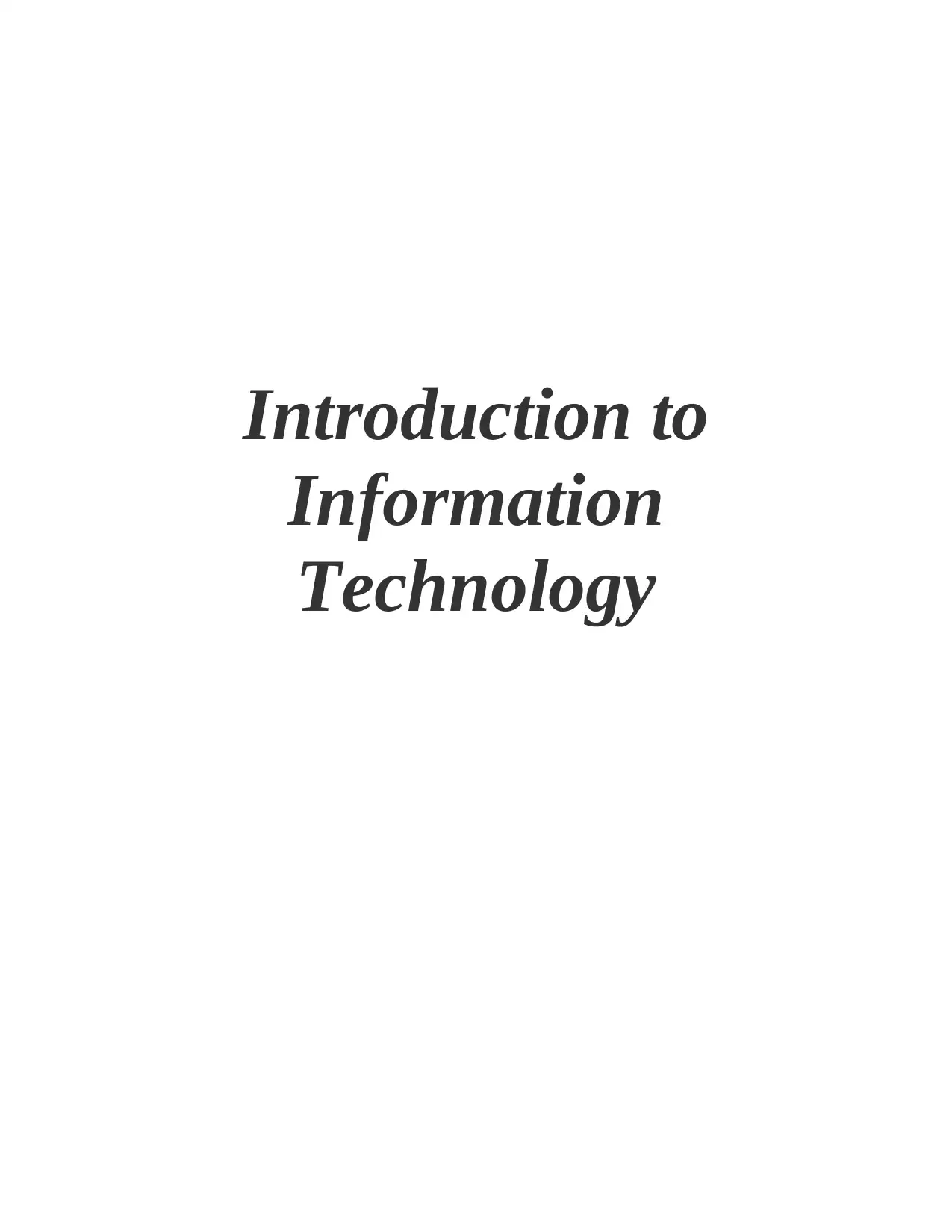
Introduction to
Information
Technology
Information
Technology
Paraphrase This Document
Need a fresh take? Get an instant paraphrase of this document with our AI Paraphraser
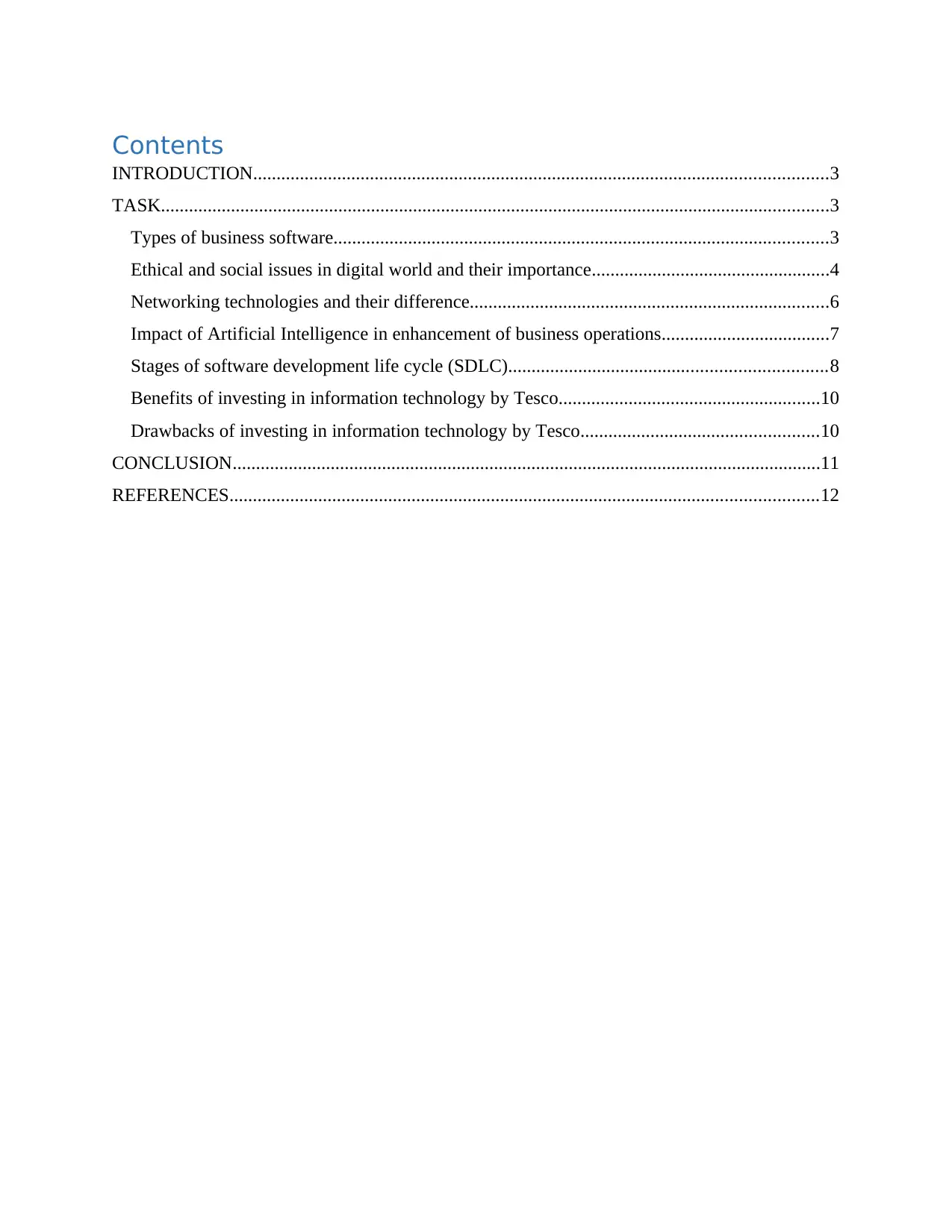
Contents
INTRODUCTION...........................................................................................................................3
TASK...............................................................................................................................................3
Types of business software..........................................................................................................3
Ethical and social issues in digital world and their importance...................................................4
Networking technologies and their difference.............................................................................6
Impact of Artificial Intelligence in enhancement of business operations....................................7
Stages of software development life cycle (SDLC)....................................................................8
Benefits of investing in information technology by Tesco........................................................10
Drawbacks of investing in information technology by Tesco...................................................10
CONCLUSION..............................................................................................................................11
REFERENCES..............................................................................................................................12
INTRODUCTION...........................................................................................................................3
TASK...............................................................................................................................................3
Types of business software..........................................................................................................3
Ethical and social issues in digital world and their importance...................................................4
Networking technologies and their difference.............................................................................6
Impact of Artificial Intelligence in enhancement of business operations....................................7
Stages of software development life cycle (SDLC)....................................................................8
Benefits of investing in information technology by Tesco........................................................10
Drawbacks of investing in information technology by Tesco...................................................10
CONCLUSION..............................................................................................................................11
REFERENCES..............................................................................................................................12
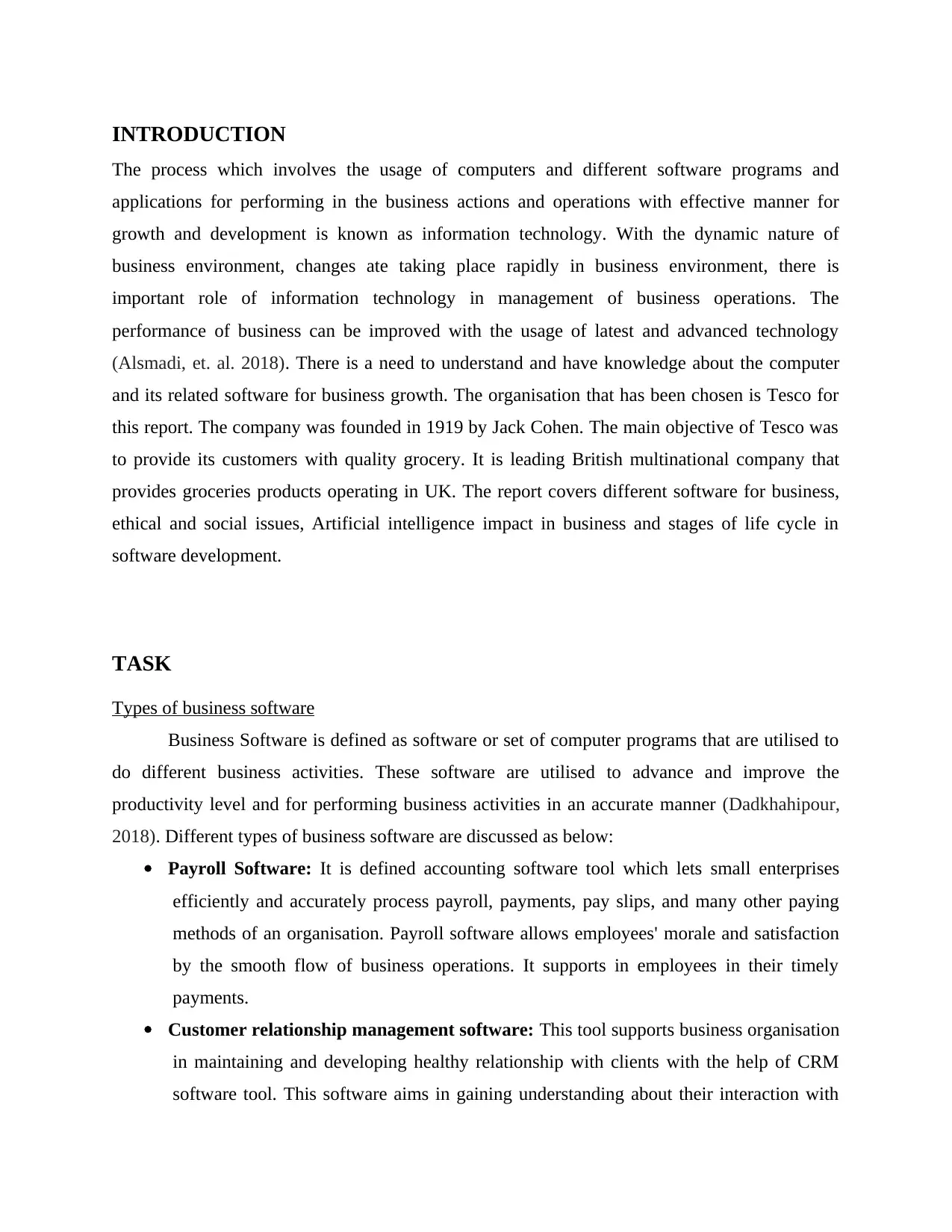
INTRODUCTION
The process which involves the usage of computers and different software programs and
applications for performing in the business actions and operations with effective manner for
growth and development is known as information technology. With the dynamic nature of
business environment, changes ate taking place rapidly in business environment, there is
important role of information technology in management of business operations. The
performance of business can be improved with the usage of latest and advanced technology
(Alsmadi, et. al. 2018). There is a need to understand and have knowledge about the computer
and its related software for business growth. The organisation that has been chosen is Tesco for
this report. The company was founded in 1919 by Jack Cohen. The main objective of Tesco was
to provide its customers with quality grocery. It is leading British multinational company that
provides groceries products operating in UK. The report covers different software for business,
ethical and social issues, Artificial intelligence impact in business and stages of life cycle in
software development.
TASK
Types of business software
Business Software is defined as software or set of computer programs that are utilised to
do different business activities. These software are utilised to advance and improve the
productivity level and for performing business activities in an accurate manner (Dadkhahipour,
2018). Different types of business software are discussed as below:
Payroll Software: It is defined accounting software tool which lets small enterprises
efficiently and accurately process payroll, payments, pay slips, and many other paying
methods of an organisation. Payroll software allows employees' morale and satisfaction
by the smooth flow of business operations. It supports in employees in their timely
payments.
Customer relationship management software: This tool supports business organisation
in maintaining and developing healthy relationship with clients with the help of CRM
software tool. This software aims in gaining understanding about their interaction with
The process which involves the usage of computers and different software programs and
applications for performing in the business actions and operations with effective manner for
growth and development is known as information technology. With the dynamic nature of
business environment, changes ate taking place rapidly in business environment, there is
important role of information technology in management of business operations. The
performance of business can be improved with the usage of latest and advanced technology
(Alsmadi, et. al. 2018). There is a need to understand and have knowledge about the computer
and its related software for business growth. The organisation that has been chosen is Tesco for
this report. The company was founded in 1919 by Jack Cohen. The main objective of Tesco was
to provide its customers with quality grocery. It is leading British multinational company that
provides groceries products operating in UK. The report covers different software for business,
ethical and social issues, Artificial intelligence impact in business and stages of life cycle in
software development.
TASK
Types of business software
Business Software is defined as software or set of computer programs that are utilised to
do different business activities. These software are utilised to advance and improve the
productivity level and for performing business activities in an accurate manner (Dadkhahipour,
2018). Different types of business software are discussed as below:
Payroll Software: It is defined accounting software tool which lets small enterprises
efficiently and accurately process payroll, payments, pay slips, and many other paying
methods of an organisation. Payroll software allows employees' morale and satisfaction
by the smooth flow of business operations. It supports in employees in their timely
payments.
Customer relationship management software: This tool supports business organisation
in maintaining and developing healthy relationship with clients with the help of CRM
software tool. This software aims in gaining understanding about their interaction with
⊘ This is a preview!⊘
Do you want full access?
Subscribe today to unlock all pages.

Trusted by 1+ million students worldwide
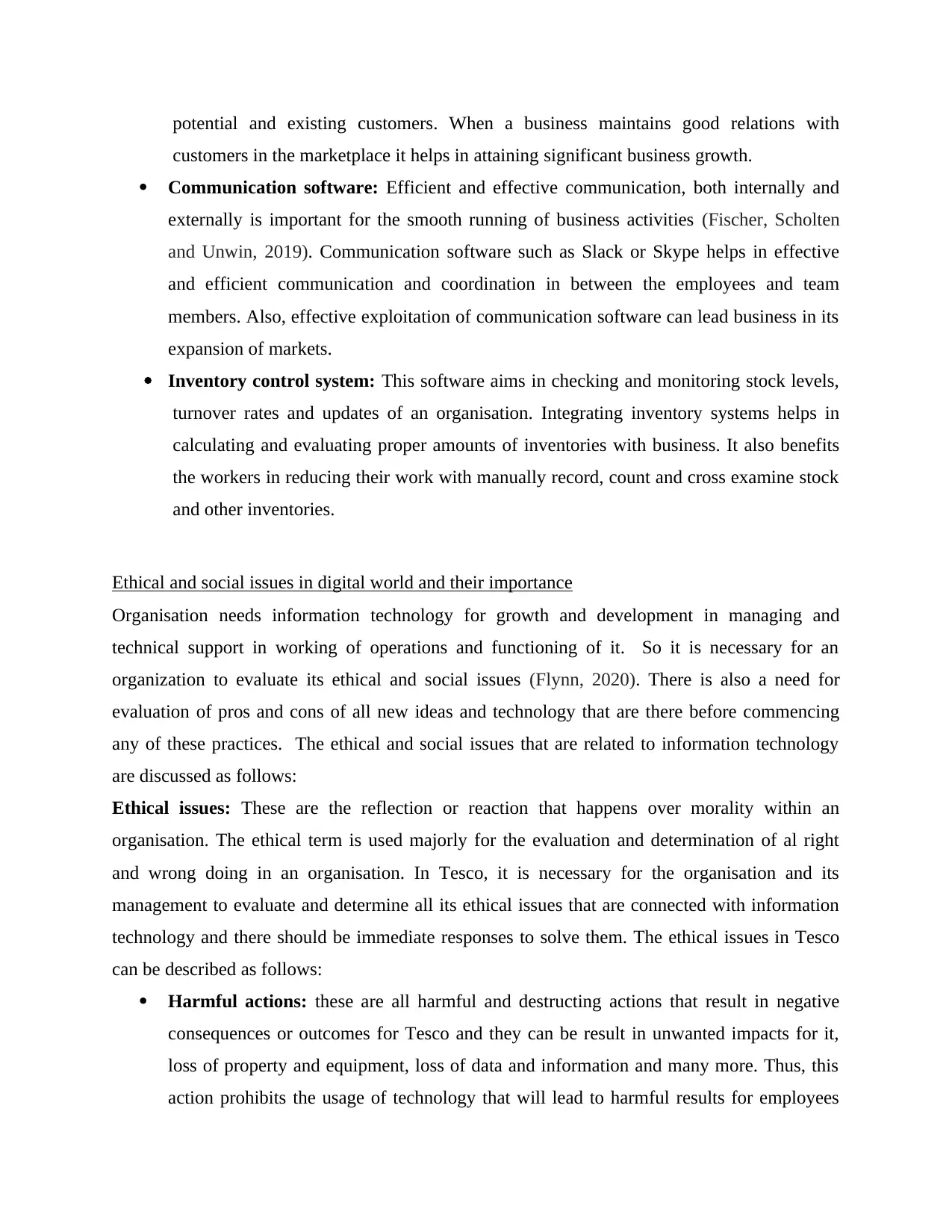
potential and existing customers. When a business maintains good relations with
customers in the marketplace it helps in attaining significant business growth.
Communication software: Efficient and effective communication, both internally and
externally is important for the smooth running of business activities (Fischer, Scholten
and Unwin, 2019). Communication software such as Slack or Skype helps in effective
and efficient communication and coordination in between the employees and team
members. Also, effective exploitation of communication software can lead business in its
expansion of markets.
Inventory control system: This software aims in checking and monitoring stock levels,
turnover rates and updates of an organisation. Integrating inventory systems helps in
calculating and evaluating proper amounts of inventories with business. It also benefits
the workers in reducing their work with manually record, count and cross examine stock
and other inventories.
Ethical and social issues in digital world and their importance
Organisation needs information technology for growth and development in managing and
technical support in working of operations and functioning of it. So it is necessary for an
organization to evaluate its ethical and social issues (Flynn, 2020). There is also a need for
evaluation of pros and cons of all new ideas and technology that are there before commencing
any of these practices. The ethical and social issues that are related to information technology
are discussed as follows:
Ethical issues: These are the reflection or reaction that happens over morality within an
organisation. The ethical term is used majorly for the evaluation and determination of al right
and wrong doing in an organisation. In Tesco, it is necessary for the organisation and its
management to evaluate and determine all its ethical issues that are connected with information
technology and there should be immediate responses to solve them. The ethical issues in Tesco
can be described as follows:
Harmful actions: these are all harmful and destructing actions that result in negative
consequences or outcomes for Tesco and they can be result in unwanted impacts for it,
loss of property and equipment, loss of data and information and many more. Thus, this
action prohibits the usage of technology that will lead to harmful results for employees
customers in the marketplace it helps in attaining significant business growth.
Communication software: Efficient and effective communication, both internally and
externally is important for the smooth running of business activities (Fischer, Scholten
and Unwin, 2019). Communication software such as Slack or Skype helps in effective
and efficient communication and coordination in between the employees and team
members. Also, effective exploitation of communication software can lead business in its
expansion of markets.
Inventory control system: This software aims in checking and monitoring stock levels,
turnover rates and updates of an organisation. Integrating inventory systems helps in
calculating and evaluating proper amounts of inventories with business. It also benefits
the workers in reducing their work with manually record, count and cross examine stock
and other inventories.
Ethical and social issues in digital world and their importance
Organisation needs information technology for growth and development in managing and
technical support in working of operations and functioning of it. So it is necessary for an
organization to evaluate its ethical and social issues (Flynn, 2020). There is also a need for
evaluation of pros and cons of all new ideas and technology that are there before commencing
any of these practices. The ethical and social issues that are related to information technology
are discussed as follows:
Ethical issues: These are the reflection or reaction that happens over morality within an
organisation. The ethical term is used majorly for the evaluation and determination of al right
and wrong doing in an organisation. In Tesco, it is necessary for the organisation and its
management to evaluate and determine all its ethical issues that are connected with information
technology and there should be immediate responses to solve them. The ethical issues in Tesco
can be described as follows:
Harmful actions: these are all harmful and destructing actions that result in negative
consequences or outcomes for Tesco and they can be result in unwanted impacts for it,
loss of property and equipment, loss of data and information and many more. Thus, this
action prohibits the usage of technology that will lead to harmful results for employees
Paraphrase This Document
Need a fresh take? Get an instant paraphrase of this document with our AI Paraphraser
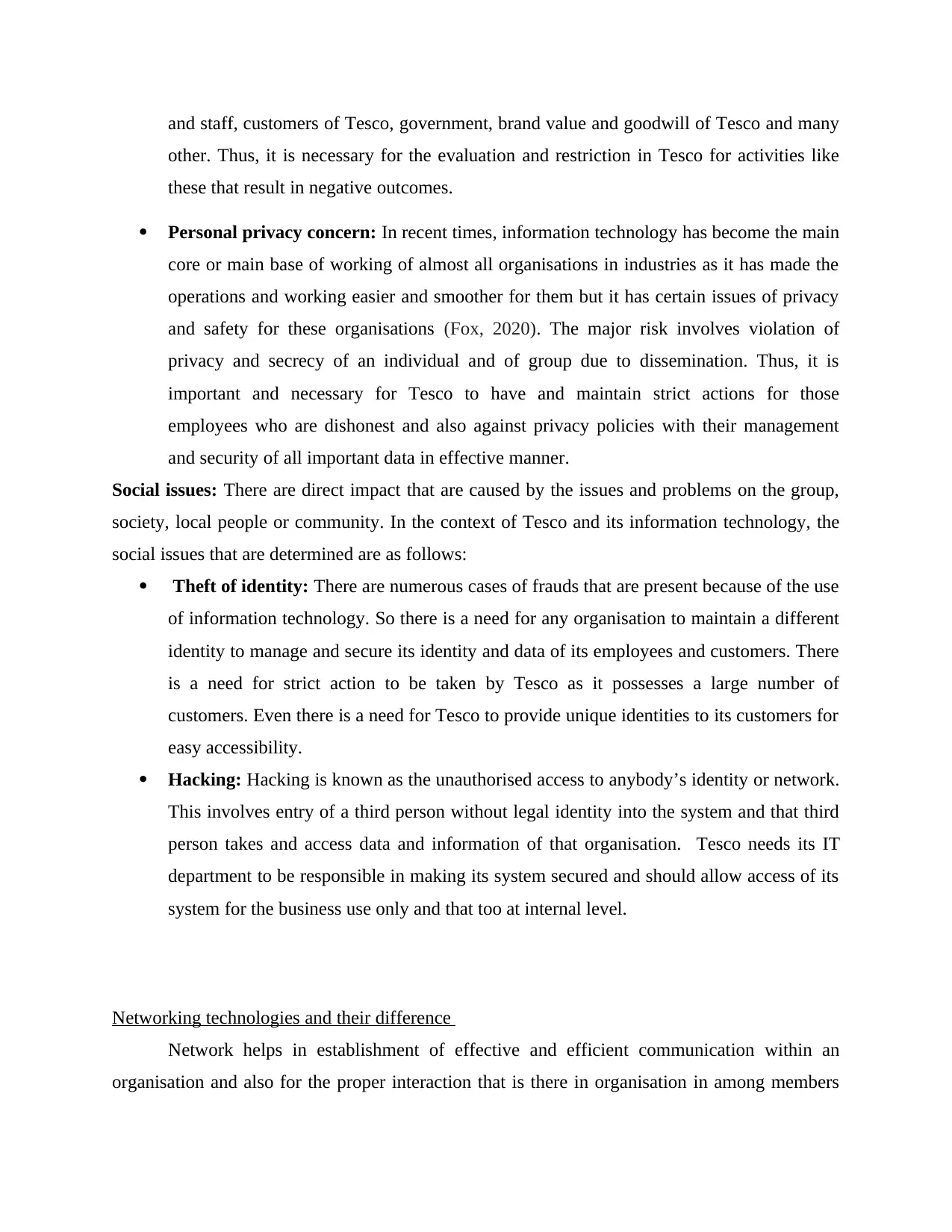
and staff, customers of Tesco, government, brand value and goodwill of Tesco and many
other. Thus, it is necessary for the evaluation and restriction in Tesco for activities like
these that result in negative outcomes.
Personal privacy concern: In recent times, information technology has become the main
core or main base of working of almost all organisations in industries as it has made the
operations and working easier and smoother for them but it has certain issues of privacy
and safety for these organisations (Fox, 2020). The major risk involves violation of
privacy and secrecy of an individual and of group due to dissemination. Thus, it is
important and necessary for Tesco to have and maintain strict actions for those
employees who are dishonest and also against privacy policies with their management
and security of all important data in effective manner.
Social issues: There are direct impact that are caused by the issues and problems on the group,
society, local people or community. In the context of Tesco and its information technology, the
social issues that are determined are as follows:
Theft of identity: There are numerous cases of frauds that are present because of the use
of information technology. So there is a need for any organisation to maintain a different
identity to manage and secure its identity and data of its employees and customers. There
is a need for strict action to be taken by Tesco as it possesses a large number of
customers. Even there is a need for Tesco to provide unique identities to its customers for
easy accessibility.
Hacking: Hacking is known as the unauthorised access to anybody’s identity or network.
This involves entry of a third person without legal identity into the system and that third
person takes and access data and information of that organisation. Tesco needs its IT
department to be responsible in making its system secured and should allow access of its
system for the business use only and that too at internal level.
Networking technologies and their difference
Network helps in establishment of effective and efficient communication within an
organisation and also for the proper interaction that is there in organisation in among members
other. Thus, it is necessary for the evaluation and restriction in Tesco for activities like
these that result in negative outcomes.
Personal privacy concern: In recent times, information technology has become the main
core or main base of working of almost all organisations in industries as it has made the
operations and working easier and smoother for them but it has certain issues of privacy
and safety for these organisations (Fox, 2020). The major risk involves violation of
privacy and secrecy of an individual and of group due to dissemination. Thus, it is
important and necessary for Tesco to have and maintain strict actions for those
employees who are dishonest and also against privacy policies with their management
and security of all important data in effective manner.
Social issues: There are direct impact that are caused by the issues and problems on the group,
society, local people or community. In the context of Tesco and its information technology, the
social issues that are determined are as follows:
Theft of identity: There are numerous cases of frauds that are present because of the use
of information technology. So there is a need for any organisation to maintain a different
identity to manage and secure its identity and data of its employees and customers. There
is a need for strict action to be taken by Tesco as it possesses a large number of
customers. Even there is a need for Tesco to provide unique identities to its customers for
easy accessibility.
Hacking: Hacking is known as the unauthorised access to anybody’s identity or network.
This involves entry of a third person without legal identity into the system and that third
person takes and access data and information of that organisation. Tesco needs its IT
department to be responsible in making its system secured and should allow access of its
system for the business use only and that too at internal level.
Networking technologies and their difference
Network helps in establishment of effective and efficient communication within an
organisation and also for the proper interaction that is there in organisation in among members
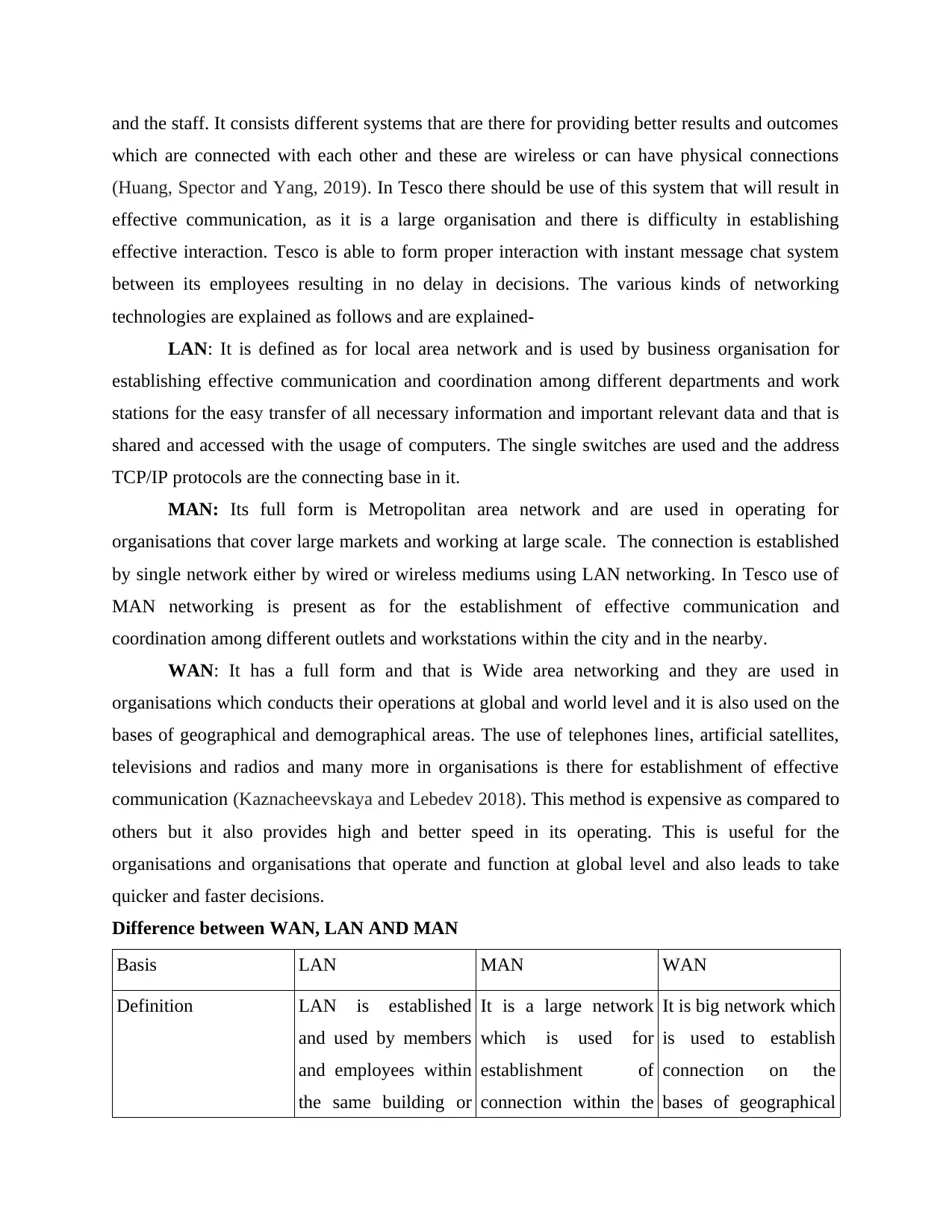
and the staff. It consists different systems that are there for providing better results and outcomes
which are connected with each other and these are wireless or can have physical connections
(Huang, Spector and Yang, 2019). In Tesco there should be use of this system that will result in
effective communication, as it is a large organisation and there is difficulty in establishing
effective interaction. Tesco is able to form proper interaction with instant message chat system
between its employees resulting in no delay in decisions. The various kinds of networking
technologies are explained as follows and are explained-
LAN: It is defined as for local area network and is used by business organisation for
establishing effective communication and coordination among different departments and work
stations for the easy transfer of all necessary information and important relevant data and that is
shared and accessed with the usage of computers. The single switches are used and the address
TCP/IP protocols are the connecting base in it.
MAN: Its full form is Metropolitan area network and are used in operating for
organisations that cover large markets and working at large scale. The connection is established
by single network either by wired or wireless mediums using LAN networking. In Tesco use of
MAN networking is present as for the establishment of effective communication and
coordination among different outlets and workstations within the city and in the nearby.
WAN: It has a full form and that is Wide area networking and they are used in
organisations which conducts their operations at global and world level and it is also used on the
bases of geographical and demographical areas. The use of telephones lines, artificial satellites,
televisions and radios and many more in organisations is there for establishment of effective
communication (Kaznacheevskaya and Lebedev 2018). This method is expensive as compared to
others but it also provides high and better speed in its operating. This is useful for the
organisations and organisations that operate and function at global level and also leads to take
quicker and faster decisions.
Difference between WAN, LAN AND MAN
Basis LAN MAN WAN
Definition LAN is established
and used by members
and employees within
the same building or
It is a large network
which is used for
establishment of
connection within the
It is big network which
is used to establish
connection on the
bases of geographical
which are connected with each other and these are wireless or can have physical connections
(Huang, Spector and Yang, 2019). In Tesco there should be use of this system that will result in
effective communication, as it is a large organisation and there is difficulty in establishing
effective interaction. Tesco is able to form proper interaction with instant message chat system
between its employees resulting in no delay in decisions. The various kinds of networking
technologies are explained as follows and are explained-
LAN: It is defined as for local area network and is used by business organisation for
establishing effective communication and coordination among different departments and work
stations for the easy transfer of all necessary information and important relevant data and that is
shared and accessed with the usage of computers. The single switches are used and the address
TCP/IP protocols are the connecting base in it.
MAN: Its full form is Metropolitan area network and are used in operating for
organisations that cover large markets and working at large scale. The connection is established
by single network either by wired or wireless mediums using LAN networking. In Tesco use of
MAN networking is present as for the establishment of effective communication and
coordination among different outlets and workstations within the city and in the nearby.
WAN: It has a full form and that is Wide area networking and they are used in
organisations which conducts their operations at global and world level and it is also used on the
bases of geographical and demographical areas. The use of telephones lines, artificial satellites,
televisions and radios and many more in organisations is there for establishment of effective
communication (Kaznacheevskaya and Lebedev 2018). This method is expensive as compared to
others but it also provides high and better speed in its operating. This is useful for the
organisations and organisations that operate and function at global level and also leads to take
quicker and faster decisions.
Difference between WAN, LAN AND MAN
Basis LAN MAN WAN
Definition LAN is established
and used by members
and employees within
the same building or
It is a large network
which is used for
establishment of
connection within the
It is big network which
is used to establish
connection on the
bases of geographical
⊘ This is a preview!⊘
Do you want full access?
Subscribe today to unlock all pages.

Trusted by 1+ million students worldwide
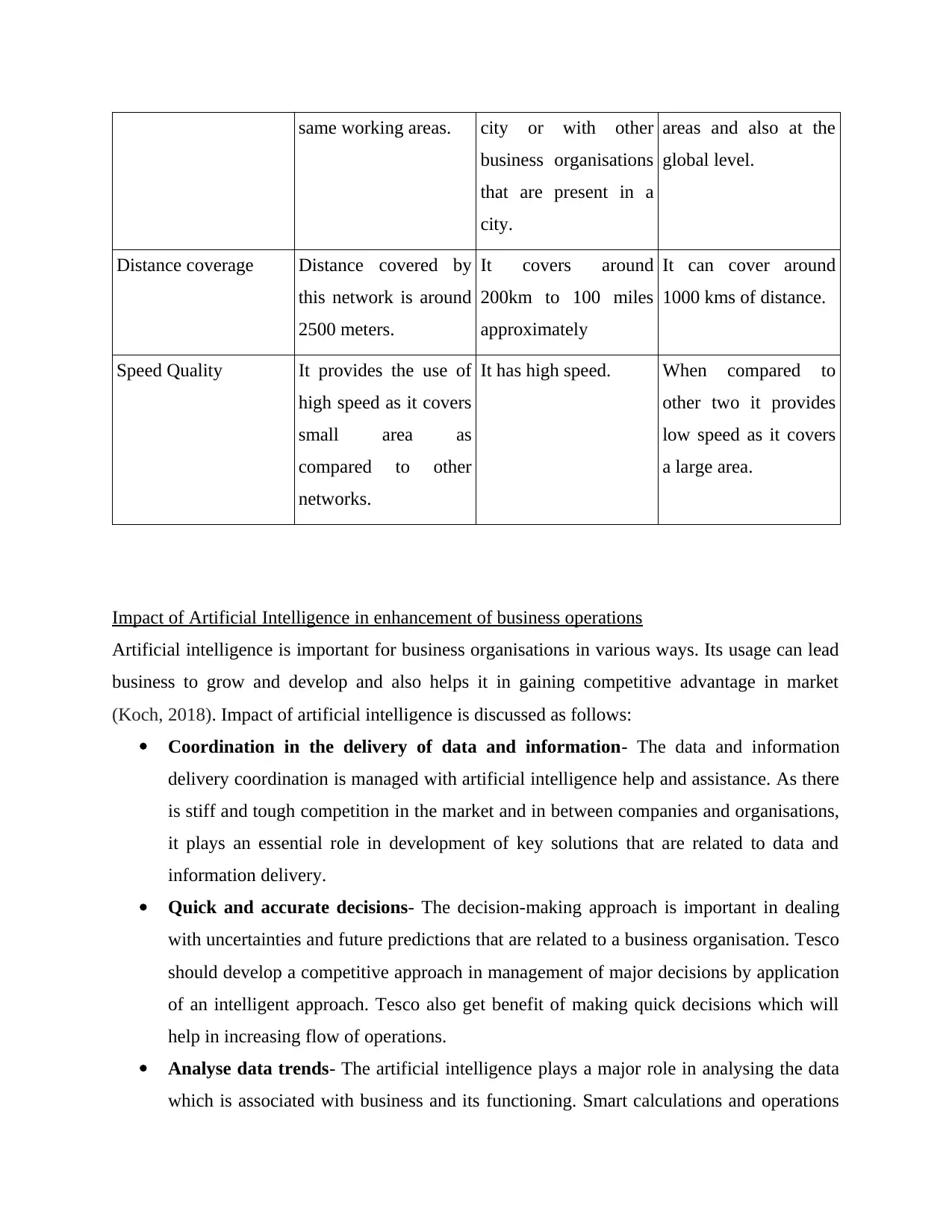
same working areas. city or with other
business organisations
that are present in a
city.
areas and also at the
global level.
Distance coverage Distance covered by
this network is around
2500 meters.
It covers around
200km to 100 miles
approximately
It can cover around
1000 kms of distance.
Speed Quality It provides the use of
high speed as it covers
small area as
compared to other
networks.
It has high speed. When compared to
other two it provides
low speed as it covers
a large area.
Impact of Artificial Intelligence in enhancement of business operations
Artificial intelligence is important for business organisations in various ways. Its usage can lead
business to grow and develop and also helps it in gaining competitive advantage in market
(Koch, 2018). Impact of artificial intelligence is discussed as follows:
Coordination in the delivery of data and information- The data and information
delivery coordination is managed with artificial intelligence help and assistance. As there
is stiff and tough competition in the market and in between companies and organisations,
it plays an essential role in development of key solutions that are related to data and
information delivery.
Quick and accurate decisions- The decision-making approach is important in dealing
with uncertainties and future predictions that are related to a business organisation. Tesco
should develop a competitive approach in management of major decisions by application
of an intelligent approach. Tesco also get benefit of making quick decisions which will
help in increasing flow of operations.
Analyse data trends- The artificial intelligence plays a major role in analysing the data
which is associated with business and its functioning. Smart calculations and operations
business organisations
that are present in a
city.
areas and also at the
global level.
Distance coverage Distance covered by
this network is around
2500 meters.
It covers around
200km to 100 miles
approximately
It can cover around
1000 kms of distance.
Speed Quality It provides the use of
high speed as it covers
small area as
compared to other
networks.
It has high speed. When compared to
other two it provides
low speed as it covers
a large area.
Impact of Artificial Intelligence in enhancement of business operations
Artificial intelligence is important for business organisations in various ways. Its usage can lead
business to grow and develop and also helps it in gaining competitive advantage in market
(Koch, 2018). Impact of artificial intelligence is discussed as follows:
Coordination in the delivery of data and information- The data and information
delivery coordination is managed with artificial intelligence help and assistance. As there
is stiff and tough competition in the market and in between companies and organisations,
it plays an essential role in development of key solutions that are related to data and
information delivery.
Quick and accurate decisions- The decision-making approach is important in dealing
with uncertainties and future predictions that are related to a business organisation. Tesco
should develop a competitive approach in management of major decisions by application
of an intelligent approach. Tesco also get benefit of making quick decisions which will
help in increasing flow of operations.
Analyse data trends- The artificial intelligence plays a major role in analysing the data
which is associated with business and its functioning. Smart calculations and operations
Paraphrase This Document
Need a fresh take? Get an instant paraphrase of this document with our AI Paraphraser
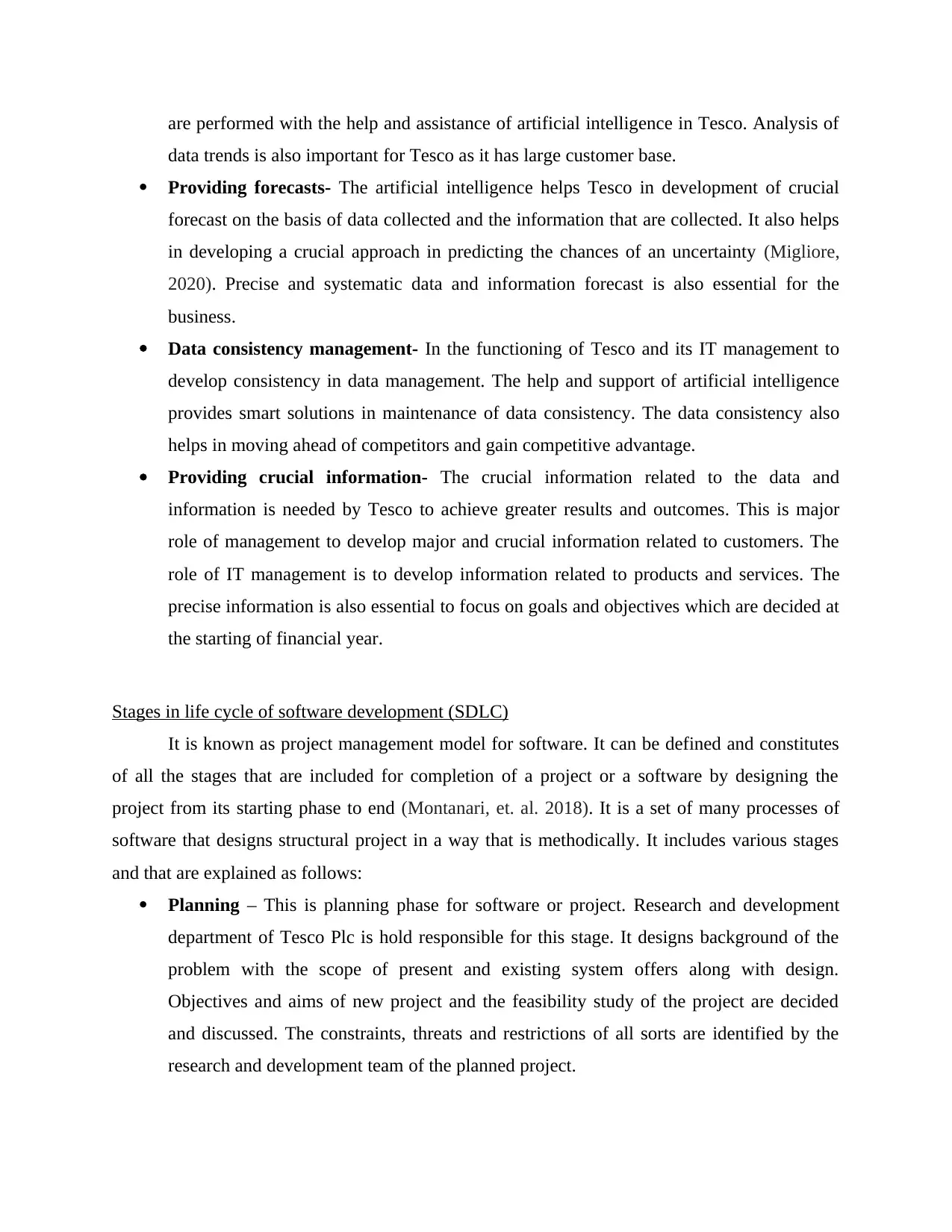
are performed with the help and assistance of artificial intelligence in Tesco. Analysis of
data trends is also important for Tesco as it has large customer base.
Providing forecasts- The artificial intelligence helps Tesco in development of crucial
forecast on the basis of data collected and the information that are collected. It also helps
in developing a crucial approach in predicting the chances of an uncertainty (Migliore,
2020). Precise and systematic data and information forecast is also essential for the
business.
Data consistency management- In the functioning of Tesco and its IT management to
develop consistency in data management. The help and support of artificial intelligence
provides smart solutions in maintenance of data consistency. The data consistency also
helps in moving ahead of competitors and gain competitive advantage.
Providing crucial information- The crucial information related to the data and
information is needed by Tesco to achieve greater results and outcomes. This is major
role of management to develop major and crucial information related to customers. The
role of IT management is to develop information related to products and services. The
precise information is also essential to focus on goals and objectives which are decided at
the starting of financial year.
Stages in life cycle of software development (SDLC)
It is known as project management model for software. It can be defined and constitutes
of all the stages that are included for completion of a project or a software by designing the
project from its starting phase to end (Montanari, et. al. 2018). It is a set of many processes of
software that designs structural project in a way that is methodically. It includes various stages
and that are explained as follows:
Planning – This is planning phase for software or project. Research and development
department of Tesco Plc is hold responsible for this stage. It designs background of the
problem with the scope of present and existing system offers along with design.
Objectives and aims of new project and the feasibility study of the project are decided
and discussed. The constraints, threats and restrictions of all sorts are identified by the
research and development team of the planned project.
data trends is also important for Tesco as it has large customer base.
Providing forecasts- The artificial intelligence helps Tesco in development of crucial
forecast on the basis of data collected and the information that are collected. It also helps
in developing a crucial approach in predicting the chances of an uncertainty (Migliore,
2020). Precise and systematic data and information forecast is also essential for the
business.
Data consistency management- In the functioning of Tesco and its IT management to
develop consistency in data management. The help and support of artificial intelligence
provides smart solutions in maintenance of data consistency. The data consistency also
helps in moving ahead of competitors and gain competitive advantage.
Providing crucial information- The crucial information related to the data and
information is needed by Tesco to achieve greater results and outcomes. This is major
role of management to develop major and crucial information related to customers. The
role of IT management is to develop information related to products and services. The
precise information is also essential to focus on goals and objectives which are decided at
the starting of financial year.
Stages in life cycle of software development (SDLC)
It is known as project management model for software. It can be defined and constitutes
of all the stages that are included for completion of a project or a software by designing the
project from its starting phase to end (Montanari, et. al. 2018). It is a set of many processes of
software that designs structural project in a way that is methodically. It includes various stages
and that are explained as follows:
Planning – This is planning phase for software or project. Research and development
department of Tesco Plc is hold responsible for this stage. It designs background of the
problem with the scope of present and existing system offers along with design.
Objectives and aims of new project and the feasibility study of the project are decided
and discussed. The constraints, threats and restrictions of all sorts are identified by the
research and development team of the planned project.
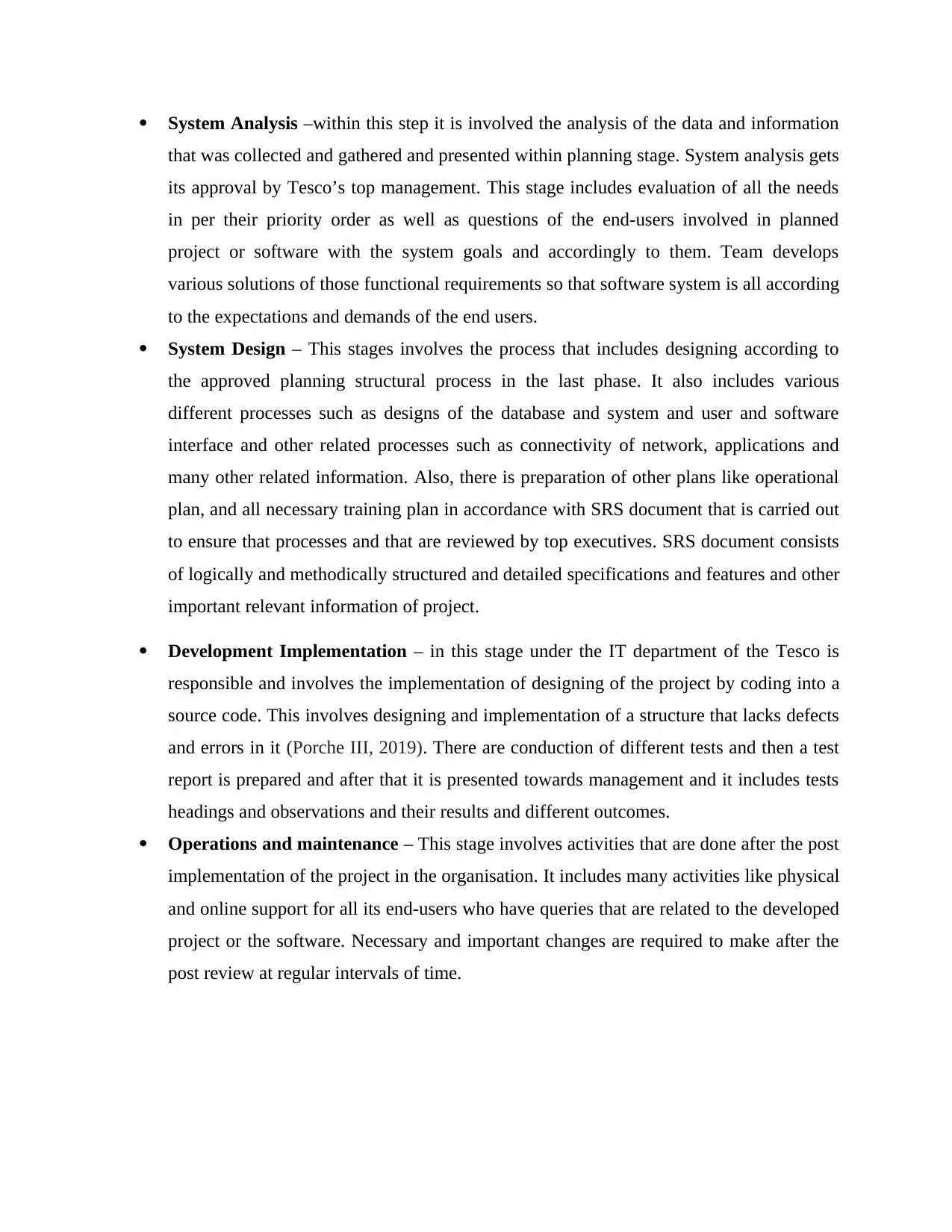
System Analysis –within this step it is involved the analysis of the data and information
that was collected and gathered and presented within planning stage. System analysis gets
its approval by Tesco’s top management. This stage includes evaluation of all the needs
in per their priority order as well as questions of the end-users involved in planned
project or software with the system goals and accordingly to them. Team develops
various solutions of those functional requirements so that software system is all according
to the expectations and demands of the end users.
System Design – This stages involves the process that includes designing according to
the approved planning structural process in the last phase. It also includes various
different processes such as designs of the database and system and user and software
interface and other related processes such as connectivity of network, applications and
many other related information. Also, there is preparation of other plans like operational
plan, and all necessary training plan in accordance with SRS document that is carried out
to ensure that processes and that are reviewed by top executives. SRS document consists
of logically and methodically structured and detailed specifications and features and other
important relevant information of project.
Development Implementation – in this stage under the IT department of the Tesco is
responsible and involves the implementation of designing of the project by coding into a
source code. This involves designing and implementation of a structure that lacks defects
and errors in it (Porche III, 2019). There are conduction of different tests and then a test
report is prepared and after that it is presented towards management and it includes tests
headings and observations and their results and different outcomes.
Operations and maintenance – This stage involves activities that are done after the post
implementation of the project in the organisation. It includes many activities like physical
and online support for all its end-users who have queries that are related to the developed
project or the software. Necessary and important changes are required to make after the
post review at regular intervals of time.
that was collected and gathered and presented within planning stage. System analysis gets
its approval by Tesco’s top management. This stage includes evaluation of all the needs
in per their priority order as well as questions of the end-users involved in planned
project or software with the system goals and accordingly to them. Team develops
various solutions of those functional requirements so that software system is all according
to the expectations and demands of the end users.
System Design – This stages involves the process that includes designing according to
the approved planning structural process in the last phase. It also includes various
different processes such as designs of the database and system and user and software
interface and other related processes such as connectivity of network, applications and
many other related information. Also, there is preparation of other plans like operational
plan, and all necessary training plan in accordance with SRS document that is carried out
to ensure that processes and that are reviewed by top executives. SRS document consists
of logically and methodically structured and detailed specifications and features and other
important relevant information of project.
Development Implementation – in this stage under the IT department of the Tesco is
responsible and involves the implementation of designing of the project by coding into a
source code. This involves designing and implementation of a structure that lacks defects
and errors in it (Porche III, 2019). There are conduction of different tests and then a test
report is prepared and after that it is presented towards management and it includes tests
headings and observations and their results and different outcomes.
Operations and maintenance – This stage involves activities that are done after the post
implementation of the project in the organisation. It includes many activities like physical
and online support for all its end-users who have queries that are related to the developed
project or the software. Necessary and important changes are required to make after the
post review at regular intervals of time.
⊘ This is a preview!⊘
Do you want full access?
Subscribe today to unlock all pages.

Trusted by 1+ million students worldwide
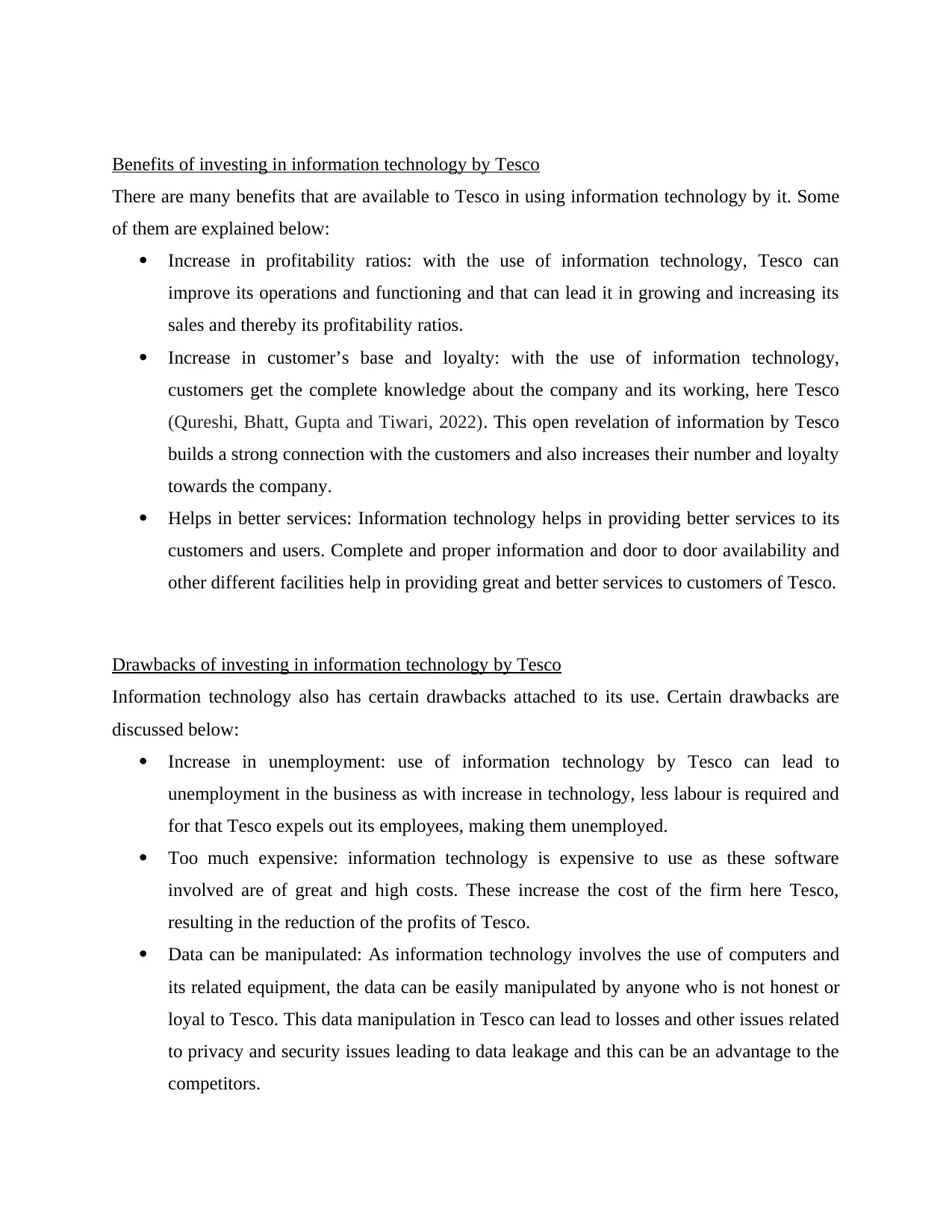
Benefits of investing in information technology by Tesco
There are many benefits that are available to Tesco in using information technology by it. Some
of them are explained below:
Increase in profitability ratios: with the use of information technology, Tesco can
improve its operations and functioning and that can lead it in growing and increasing its
sales and thereby its profitability ratios.
Increase in customer’s base and loyalty: with the use of information technology,
customers get the complete knowledge about the company and its working, here Tesco
(Qureshi, Bhatt, Gupta and Tiwari, 2022). This open revelation of information by Tesco
builds a strong connection with the customers and also increases their number and loyalty
towards the company.
Helps in better services: Information technology helps in providing better services to its
customers and users. Complete and proper information and door to door availability and
other different facilities help in providing great and better services to customers of Tesco.
Drawbacks of investing in information technology by Tesco
Information technology also has certain drawbacks attached to its use. Certain drawbacks are
discussed below:
Increase in unemployment: use of information technology by Tesco can lead to
unemployment in the business as with increase in technology, less labour is required and
for that Tesco expels out its employees, making them unemployed.
Too much expensive: information technology is expensive to use as these software
involved are of great and high costs. These increase the cost of the firm here Tesco,
resulting in the reduction of the profits of Tesco.
Data can be manipulated: As information technology involves the use of computers and
its related equipment, the data can be easily manipulated by anyone who is not honest or
loyal to Tesco. This data manipulation in Tesco can lead to losses and other issues related
to privacy and security issues leading to data leakage and this can be an advantage to the
competitors.
There are many benefits that are available to Tesco in using information technology by it. Some
of them are explained below:
Increase in profitability ratios: with the use of information technology, Tesco can
improve its operations and functioning and that can lead it in growing and increasing its
sales and thereby its profitability ratios.
Increase in customer’s base and loyalty: with the use of information technology,
customers get the complete knowledge about the company and its working, here Tesco
(Qureshi, Bhatt, Gupta and Tiwari, 2022). This open revelation of information by Tesco
builds a strong connection with the customers and also increases their number and loyalty
towards the company.
Helps in better services: Information technology helps in providing better services to its
customers and users. Complete and proper information and door to door availability and
other different facilities help in providing great and better services to customers of Tesco.
Drawbacks of investing in information technology by Tesco
Information technology also has certain drawbacks attached to its use. Certain drawbacks are
discussed below:
Increase in unemployment: use of information technology by Tesco can lead to
unemployment in the business as with increase in technology, less labour is required and
for that Tesco expels out its employees, making them unemployed.
Too much expensive: information technology is expensive to use as these software
involved are of great and high costs. These increase the cost of the firm here Tesco,
resulting in the reduction of the profits of Tesco.
Data can be manipulated: As information technology involves the use of computers and
its related equipment, the data can be easily manipulated by anyone who is not honest or
loyal to Tesco. This data manipulation in Tesco can lead to losses and other issues related
to privacy and security issues leading to data leakage and this can be an advantage to the
competitors.
Paraphrase This Document
Need a fresh take? Get an instant paraphrase of this document with our AI Paraphraser
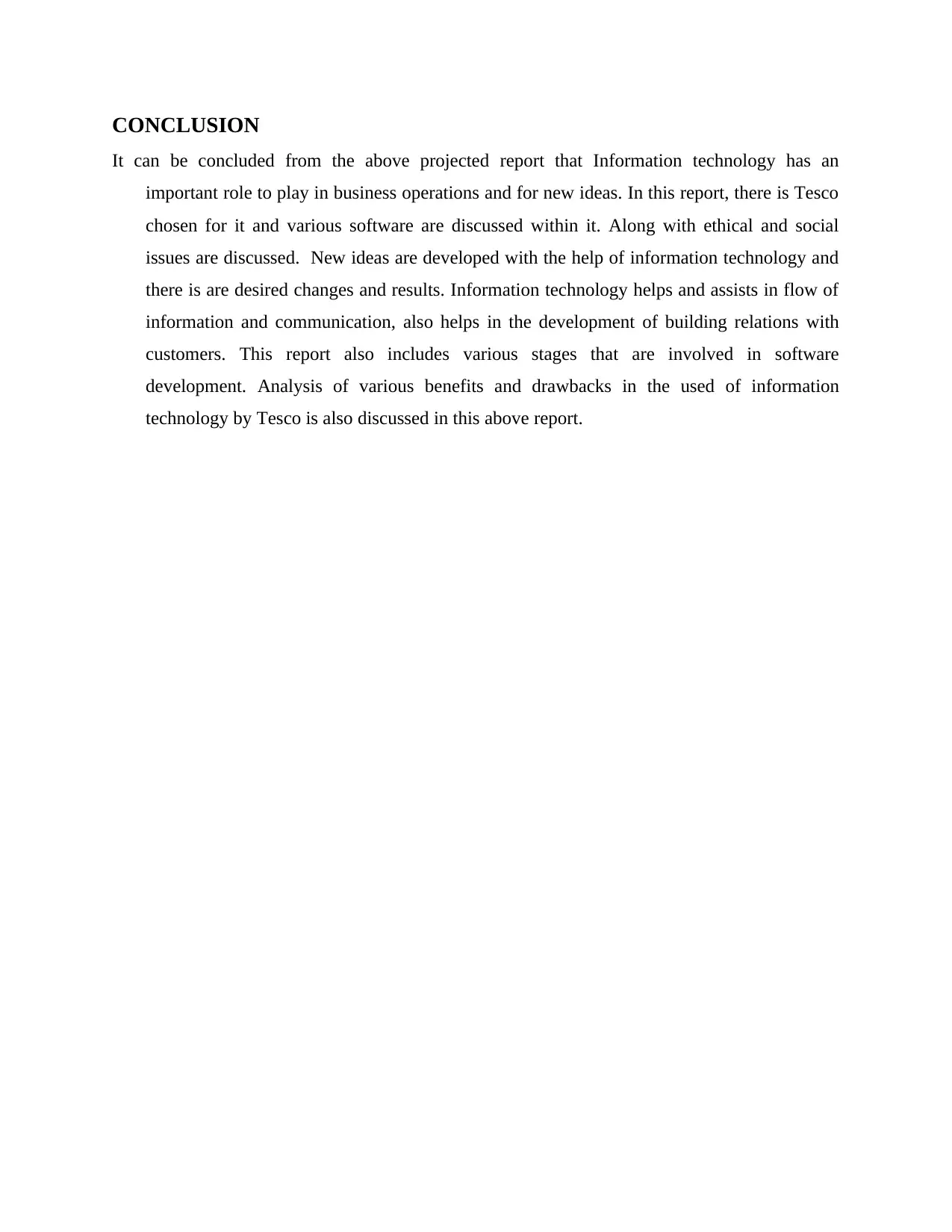
CONCLUSION
It can be concluded from the above projected report that Information technology has an
important role to play in business operations and for new ideas. In this report, there is Tesco
chosen for it and various software are discussed within it. Along with ethical and social
issues are discussed. New ideas are developed with the help of information technology and
there is are desired changes and results. Information technology helps and assists in flow of
information and communication, also helps in the development of building relations with
customers. This report also includes various stages that are involved in software
development. Analysis of various benefits and drawbacks in the used of information
technology by Tesco is also discussed in this above report.
It can be concluded from the above projected report that Information technology has an
important role to play in business operations and for new ideas. In this report, there is Tesco
chosen for it and various software are discussed within it. Along with ethical and social
issues are discussed. New ideas are developed with the help of information technology and
there is are desired changes and results. Information technology helps and assists in flow of
information and communication, also helps in the development of building relations with
customers. This report also includes various stages that are involved in software
development. Analysis of various benefits and drawbacks in the used of information
technology by Tesco is also discussed in this above report.
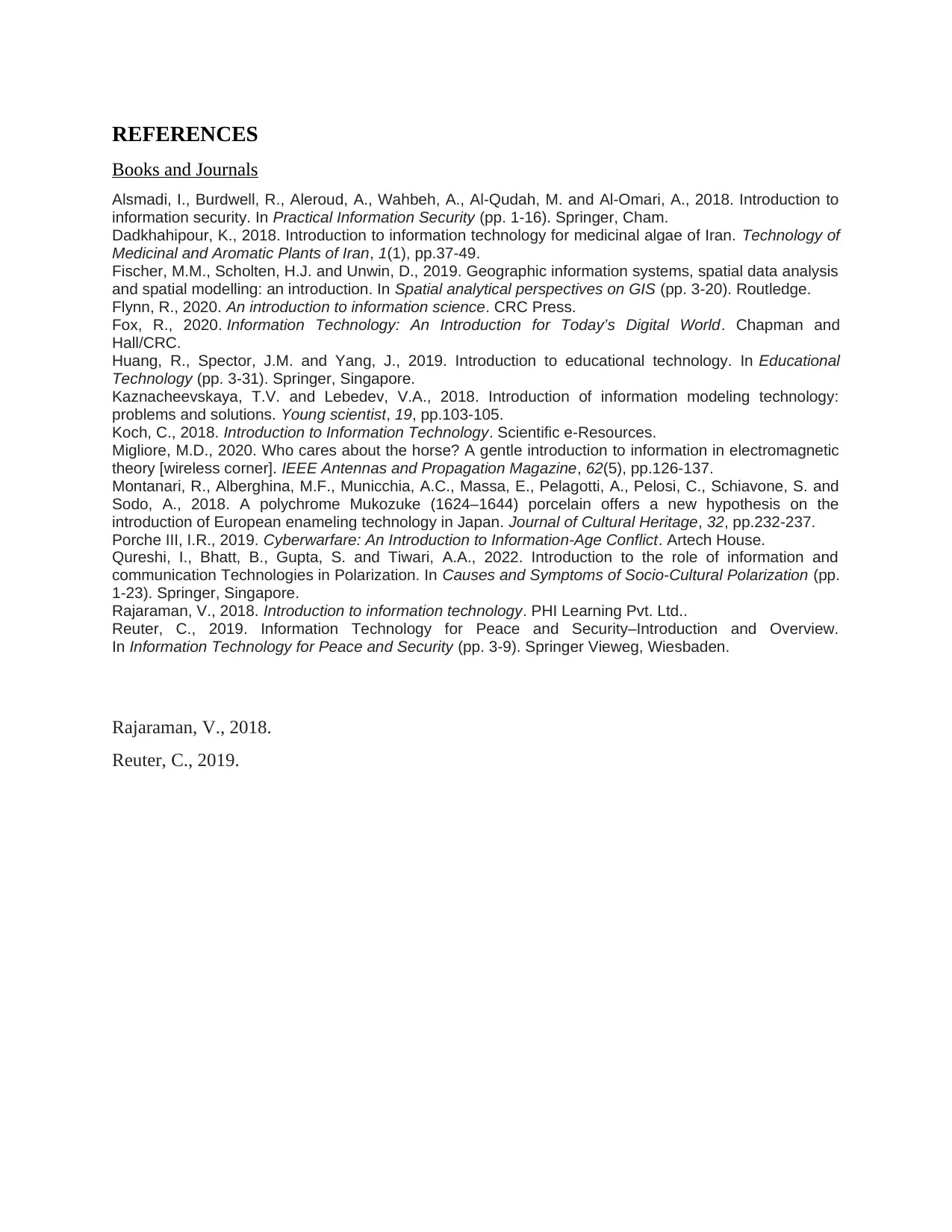
REFERENCES
Books and Journals
Alsmadi, I., Burdwell, R., Aleroud, A., Wahbeh, A., Al-Qudah, M. and Al-Omari, A., 2018. Introduction to
information security. In Practical Information Security (pp. 1-16). Springer, Cham.
Dadkhahipour, K., 2018. Introduction to information technology for medicinal algae of Iran. Technology of
Medicinal and Aromatic Plants of Iran, 1(1), pp.37-49.
Fischer, M.M., Scholten, H.J. and Unwin, D., 2019. Geographic information systems, spatial data analysis
and spatial modelling: an introduction. In Spatial analytical perspectives on GIS (pp. 3-20). Routledge.
Flynn, R., 2020. An introduction to information science. CRC Press.
Fox, R., 2020. Information Technology: An Introduction for Today’s Digital World. Chapman and
Hall/CRC.
Huang, R., Spector, J.M. and Yang, J., 2019. Introduction to educational technology. In Educational
Technology (pp. 3-31). Springer, Singapore.
Kaznacheevskaya, T.V. and Lebedev, V.A., 2018. Introduction of information modeling technology:
problems and solutions. Young scientist, 19, pp.103-105.
Koch, C., 2018. Introduction to Information Technology. Scientific e-Resources.
Migliore, M.D., 2020. Who cares about the horse? A gentle introduction to information in electromagnetic
theory [wireless corner]. IEEE Antennas and Propagation Magazine, 62(5), pp.126-137.
Montanari, R., Alberghina, M.F., Municchia, A.C., Massa, E., Pelagotti, A., Pelosi, C., Schiavone, S. and
Sodo, A., 2018. A polychrome Mukozuke (1624–1644) porcelain offers a new hypothesis on the
introduction of European enameling technology in Japan. Journal of Cultural Heritage, 32, pp.232-237.
Porche III, I.R., 2019. Cyberwarfare: An Introduction to Information-Age Conflict. Artech House.
Qureshi, I., Bhatt, B., Gupta, S. and Tiwari, A.A., 2022. Introduction to the role of information and
communication Technologies in Polarization. In Causes and Symptoms of Socio-Cultural Polarization (pp.
1-23). Springer, Singapore.
Rajaraman, V., 2018. Introduction to information technology. PHI Learning Pvt. Ltd..
Reuter, C., 2019. Information Technology for Peace and Security–Introduction and Overview.
In Information Technology for Peace and Security (pp. 3-9). Springer Vieweg, Wiesbaden.
Rajaraman, V., 2018.
Reuter, C., 2019.
Books and Journals
Alsmadi, I., Burdwell, R., Aleroud, A., Wahbeh, A., Al-Qudah, M. and Al-Omari, A., 2018. Introduction to
information security. In Practical Information Security (pp. 1-16). Springer, Cham.
Dadkhahipour, K., 2018. Introduction to information technology for medicinal algae of Iran. Technology of
Medicinal and Aromatic Plants of Iran, 1(1), pp.37-49.
Fischer, M.M., Scholten, H.J. and Unwin, D., 2019. Geographic information systems, spatial data analysis
and spatial modelling: an introduction. In Spatial analytical perspectives on GIS (pp. 3-20). Routledge.
Flynn, R., 2020. An introduction to information science. CRC Press.
Fox, R., 2020. Information Technology: An Introduction for Today’s Digital World. Chapman and
Hall/CRC.
Huang, R., Spector, J.M. and Yang, J., 2019. Introduction to educational technology. In Educational
Technology (pp. 3-31). Springer, Singapore.
Kaznacheevskaya, T.V. and Lebedev, V.A., 2018. Introduction of information modeling technology:
problems and solutions. Young scientist, 19, pp.103-105.
Koch, C., 2018. Introduction to Information Technology. Scientific e-Resources.
Migliore, M.D., 2020. Who cares about the horse? A gentle introduction to information in electromagnetic
theory [wireless corner]. IEEE Antennas and Propagation Magazine, 62(5), pp.126-137.
Montanari, R., Alberghina, M.F., Municchia, A.C., Massa, E., Pelagotti, A., Pelosi, C., Schiavone, S. and
Sodo, A., 2018. A polychrome Mukozuke (1624–1644) porcelain offers a new hypothesis on the
introduction of European enameling technology in Japan. Journal of Cultural Heritage, 32, pp.232-237.
Porche III, I.R., 2019. Cyberwarfare: An Introduction to Information-Age Conflict. Artech House.
Qureshi, I., Bhatt, B., Gupta, S. and Tiwari, A.A., 2022. Introduction to the role of information and
communication Technologies in Polarization. In Causes and Symptoms of Socio-Cultural Polarization (pp.
1-23). Springer, Singapore.
Rajaraman, V., 2018. Introduction to information technology. PHI Learning Pvt. Ltd..
Reuter, C., 2019. Information Technology for Peace and Security–Introduction and Overview.
In Information Technology for Peace and Security (pp. 3-9). Springer Vieweg, Wiesbaden.
Rajaraman, V., 2018.
Reuter, C., 2019.
⊘ This is a preview!⊘
Do you want full access?
Subscribe today to unlock all pages.

Trusted by 1+ million students worldwide
1 out of 14
Related Documents
Your All-in-One AI-Powered Toolkit for Academic Success.
+13062052269
info@desklib.com
Available 24*7 on WhatsApp / Email
![[object Object]](/_next/static/media/star-bottom.7253800d.svg)
Unlock your academic potential
Copyright © 2020–2025 A2Z Services. All Rights Reserved. Developed and managed by ZUCOL.


